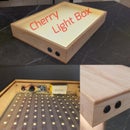Introduction: Vintage Saw Refurbishment
I've got this vintage piece as a present, a year or so ago.
To my surprise it worked. Fabulously.
The cuts were clean, the angles were reasonably true, and the upper table was stuck, together with the tilt angle...
If you look at this closely it's a piece of art, probably ~20 years old, almost no plastic in sight, over engineered aluminum parts, huge motor with no brake...
As much as I love it as is, I have some projects in line that need the upper table and some 45deg tilted cuts. So I decided to give it some love and make it great again, together with all its features. This instructable is this journey.
I hope you will find it informative and entertaining and it might even help you with your vintage machinery mending...
And if you find it really helpful, consider voting for me in the Repair and Reuse contest, thank you.
Also check this instructable in movie style.
Enjoy,
Dani
Turns out Compa is a well regarded company in the field of saws (www.compasaw.com). Unfortunately I couldn't find the specific model I have (Jet 250) and its origins, like when it was first introduced?
If you can shed some light on this, please add it in the comments.
Supplies
Nothing fancy, a socket set, several screwdrivers, allen set, soldering iron, and random stuff that we all hove around.
You might need some grease for the moving parts, thread locker, and several wooden pieces (more about this later)
Step 1: Take Apart
This step is self evident, you unscrew all the bolts and take apart the parts.
Then pile it up in one big mess, with hopes to put it back in the exact opposite order.
In my case everything was covered in wood dust, years of wood dust. Also, the bolts were untouched for years, so a significant amount of force, and WD-40, was needed to open stuff.
Step 2: Paint the Base
Once everything is one giant pile, the assembly begins.
The base is cast aluminum, and had large areas where the paint chipped off. I wanted to make it nicer, so scraped all the loose paint, masked the labels (I wanted to keep the heritage) and spray painted it with a black coat of bedliner.
This stuff is crazy taugh and gave the bare aluminum nice finish.
Step 3: Rotation and Tilt Angle Mechanism
Besides the challenging long 17mm socket (where the hell do you get one?), this was a straightforward thing.
When assembling it back, make sure you grease it extensively, all the interfaces. Don't forget to put the teflon ring back so it'll slide nicely.
Then turn it over and tighten the huge washer underneath.
Step 4: Put Back the Centering Pin
This pin is a whole assembly than locks the table at preset positions, and you can also make fine adjustments with it and use it to center the whole thing at 0.
Notice the pin is off center, so every rotation will rotate the table along with it.
So I've put it dead on 0 deg.
Also I was amazed about the amount of alignment possibilities of this saw! (this is a side note)
Step 5: New Cable
I had to open the handle.
Out of curiosity and also to make sure we don't have any hidden future problems.
To my surprise the insides were neat and simple w/o any issues. Well, besides the chewed up mains cable. So, this one had to go.
I bought a new cable and soldered the ends to the existing "end cable thingies", just because I didn't have these crimps and no crimp tool. All came out really nicely and with a shiny new cable it went back in.
Step 6: Attach the Upper Arm Assembly
The upper arm assembly rotates over this huge shaft with smaller thread stud at the end.
Clean everything and lubricate the rotation area, then slide it back in.
The tightening was over a tiny bearing that makes sure rotation is still possible.
Step 7: Spring Load the Upper Arm
Now we make sure the upper arm swings against some resistance, this is the spring that makes it possible.
Lubricate everything that's possible, especially the inner areas, where rubbing occurs.
Then, attach the rod end and, with lots of force, push the spring down and insert the retainer bolt.
All done, and it springs right back after lower dip.
Step 8: Attach the Saw Blade
This one is straightforward. Put the blade back on.
When the table is present, the handling is much harder.
Also a good idea to make sure it's aligned with the zero line.
Step 9: Make Sure the Upper Table Will Move
The upper table movement is guided by two vertical rods. The rear one is loose and moved without a problem.
The front one was stuck which made the table useless.
I took a 240grit sandpaper and sanded a little from the inside, it didn't take much time really.
After cleaning the debris the rod slid freely without any wobbles, which was the point really.
Step 10: Upper Table Surprise
After the guiding rods it was time for the table itself.
The upper table suppose to be very flat and level. And it was, at the front, and only at the front.
Towards the back it was a disaster, archy and, well, unusable as a straight cutting device.
I took it and placed it between two short wooden beams, and with a third one, and a hammer, whacked it in the center several times.
Surprisingly it didn't take much effort, and it came back to, almost, original flatness.
Step 11: Attach the Table to the Rods
In this step we use two new bolts to connect the table to the guiding rods.
Here I used a thread-locker to secure it against wobbling open.
Tighten it and check that the saw is square to the table.
Step 12: Put Back the Fence
In my case, it was ok from the beginning, just put it back and check squarenes along the blade.
Step 13: Put the Saw Back in Its Natural Environment
You're done!
Enjoy your saw and make some cool things,
Dani
You're also welcome to check out other projects, on my site or on Instagram @medanilevin or @dosimplecarbon.

Participated in the
Repair and Reuse Contest













